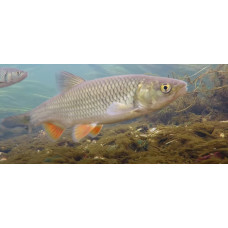River fish of the spruce family of the carp family. Widespread in water bodies of Europe and Asia. Reaches a length of 80 cm and a weight of up to 4 kg. Keeps in small flocks on rivers and sandy shoals. At the age of 4-5 years. Fertility up to 100 thousand eggs. Spawning is batch-like; first-time spawners have simultaneous spawning in early spring on stony areas. Juveniles feed on zooplankton and algae, adults on benthic organisms and young fish. An object of sport fishing.
Squalius cephalus is very beautiful. Its back is dark green, almost black, its sides are silvery with a yellowish tint, the edges of individual scales are tinged with a brilliant dark border consisting of black dots; its pectoral fins are orange, its pelvic and ventral fins with a reddish tint, and its dorsal and especially tail feathers are dark blue, sometimes somewhat sparkling; its eyes are very large, shiny, with a reddish-green spot on top. The large squalius cephalus is the closest to the barbel, but it is much longer, thicker, and broad-skinned.
Squalius cephalus has a fairly wide distribution and is found almost all over Europe, from Spain to eastern Russia. Squalius cephalus is rare in the lower reaches of rivers and is hardly ever found in estuaries and never enters the sea.
Squalius cephalus avoids large, slow-flowing rivers and its main habitat is small, fast rivers with fairly cold water. It likes sandy, stony or clay bottoms and avoids silt and mud. Under favorable conditions the fish reaches a considerable size and in this respect is superior to the ide. Ten-pounders are found almost everywhere, with the occasional 15- and 20-pounder; this fish can reach gigantic sizes when food is especially plentiful. Squalius cephalus grow much faster than roach in their early years and live over 18 years.
Spawning takes place at a water temperature of 12-17 ° C primarily in the southern regions of Europe - in April, in the north - in May and June, near the habitat. Fertility ranges from 9.7 to 200 thousand eggs. They reach sexual maturity at the end of 2-3 years of life, weighing 300-400 g. Refers to omnivorous fish, very plastic in their choice of food. It feeds on flying insects, young crayfish, fish, and frogs.
Squalius cephalus
Tags: squalius cephalus


